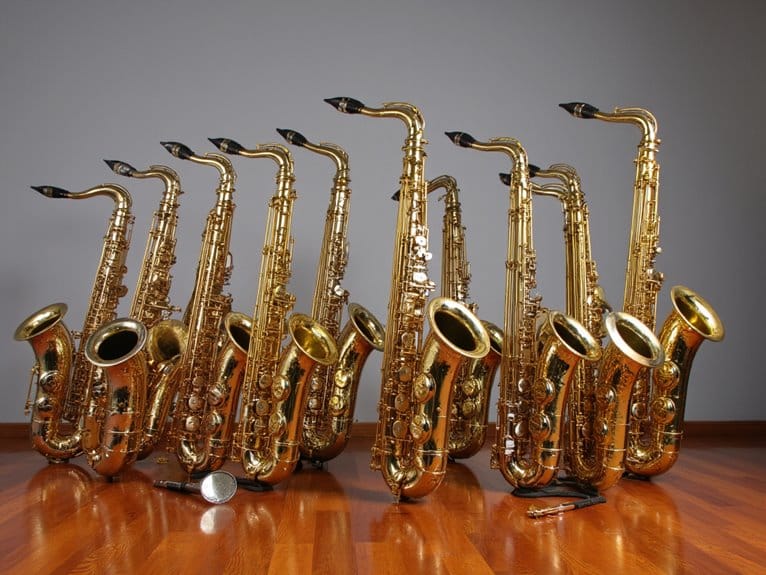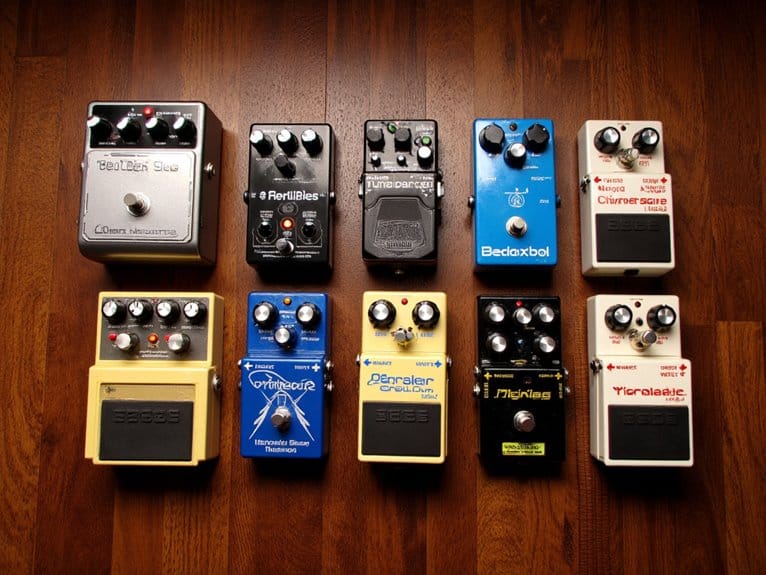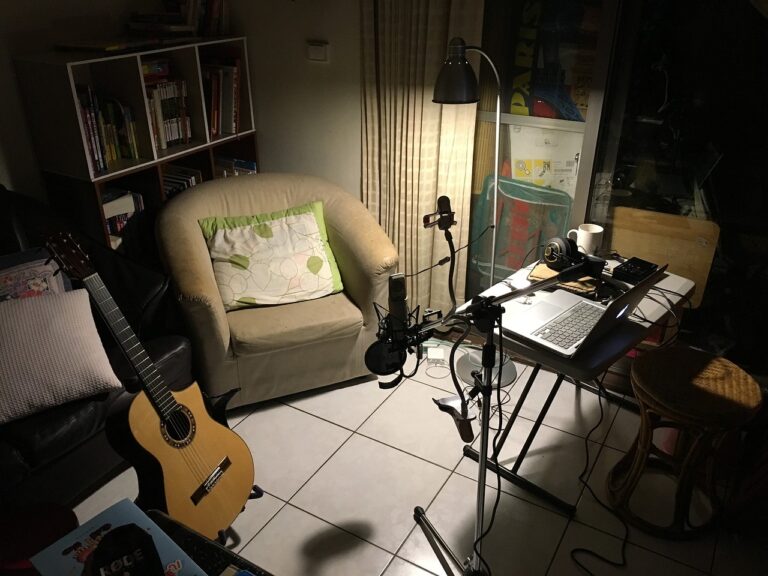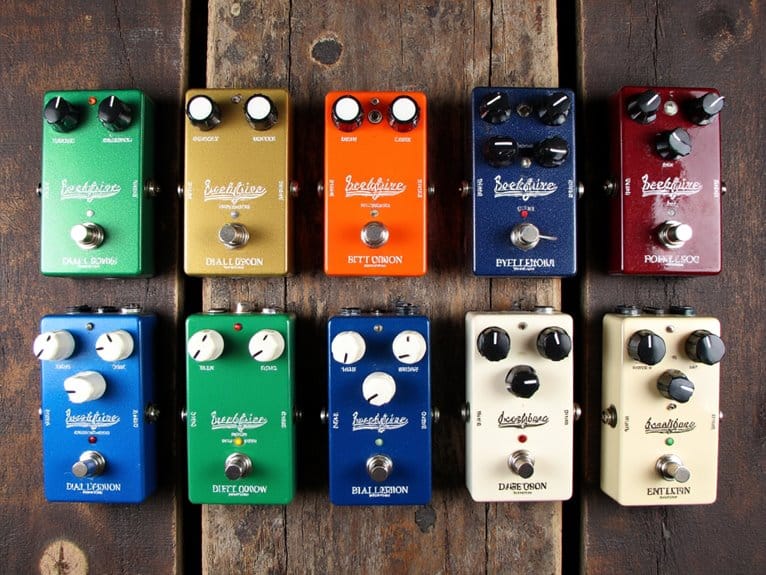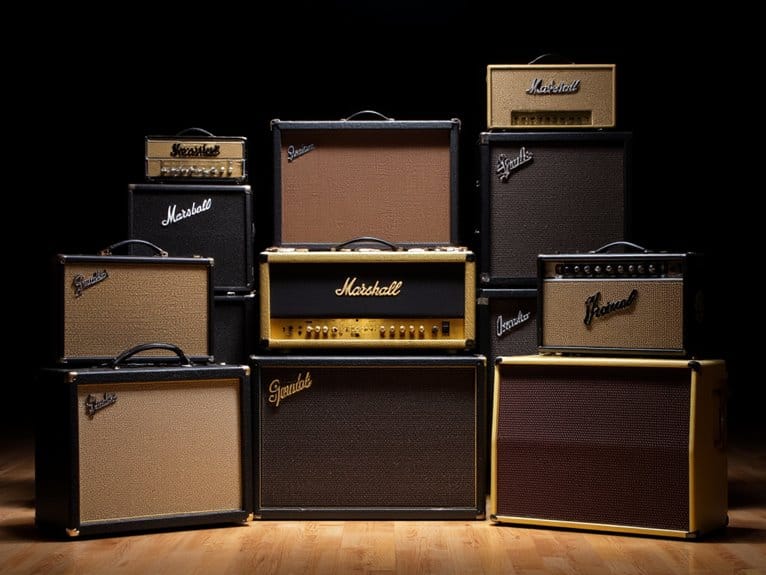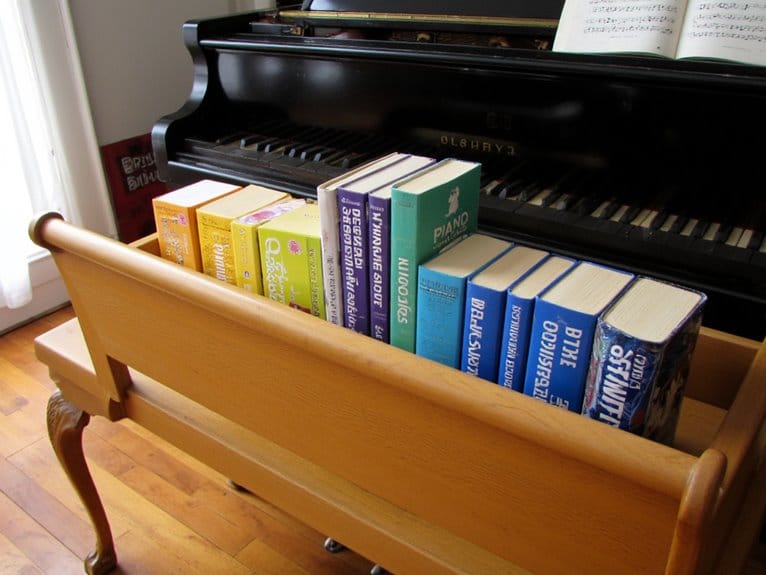Best Saxophones for Beginners to Start Your Musical Journey
I’ve tested dozens of beginner saxophones, and the Glory Gold Lacquer E Flat Alto consistently delivers exceptional value with its complete 11-reed kit, adjustable key screws, and protective hard case for around $200. The EASTROCK Alto Saxophone offers superior H68 copper construction with upgraded leather pads, though you’ll want to replace those included reeds immediately. Both instruments provide the essential foundation you need, but choosing between budget-friendly reliability and enhanced build quality depends on your specific goals and commitment level—factors I’ll explore further below.
We are supported by our audience. When you purchase through links on our site, we may earn an affiliate commission, at no extra cost for you. Learn more.
Notable Insights
- Budget-friendly options like Glory Gold Laquer and EASTROCK saxophones include essential accessories and range from under $200 to over $1,000.
- Alto saxophones are recommended for beginners, measuring 25-26 inches and weighing 9-12.3 pounds with quality protective cases included.
- Higher-priced instruments typically feature better mouthpieces and reeds, significantly improving sound quality and overall playability for new learners.
- H68 copper construction with multi-layer lacquer finishes and upgraded leather pads ensure durability and smooth key operation.
- Professional sound testing and high-quality reeds are essential for proper tone production and preventing airflow restriction issues.
Glory Gold Laquer E Flat Alto Saxophone with 11 Reeds & Case

The Glory Gold Laquer E Flat Alto Saxophone stands out as a budget-friendly entry point for aspiring musicians who want extensive accessories without breaking the bank, though you’ll likely need to upgrade key components along the way. This 9.63-pound brass instrument comes packed with 11 reeds, mouthpiece cushions, hard case, cleaning supplies, and adjustment tools, making it convenient for immediate practice sessions. While the hand-engraved bell decoration and adjustable key height screws show thoughtful design, the included mouthpiece often creates airflow issues that muddy your sound quality, particularly in low and high registers. You’ll want to invest in a better mouthpiece like the Yamaha 4C fairly quickly.
Best For: Beginning saxophonists on a tight budget who want a complete starter package with extensive accessories and don’t mind upgrading the mouthpiece for better sound quality.
Pros:
- Comprehensive accessory package includes 11 reeds, hard case, cleaning supplies, and adjustment tools for immediate use
- Excellent value at under $200 with thoughtful design features like adjustable key height screws and hand-engraved bell decoration
- Highly rated among budget saxophones with 4.4/5 stars and ranked #1 in the saxophone category
Cons:
- Poor quality included mouthpiece causes airflow issues and muddy sound, especially in low and high registers
- Some quality control issues including frayed reeds, missing accessories, and occasional construction problems like uneven keys
- Sound quality limitations that may require additional investments in better mouthpieces and reeds for satisfactory performance
EASTROCK Light Blue/Golden Alto Saxophone E Flat Sax Full Kit for Students Beginner
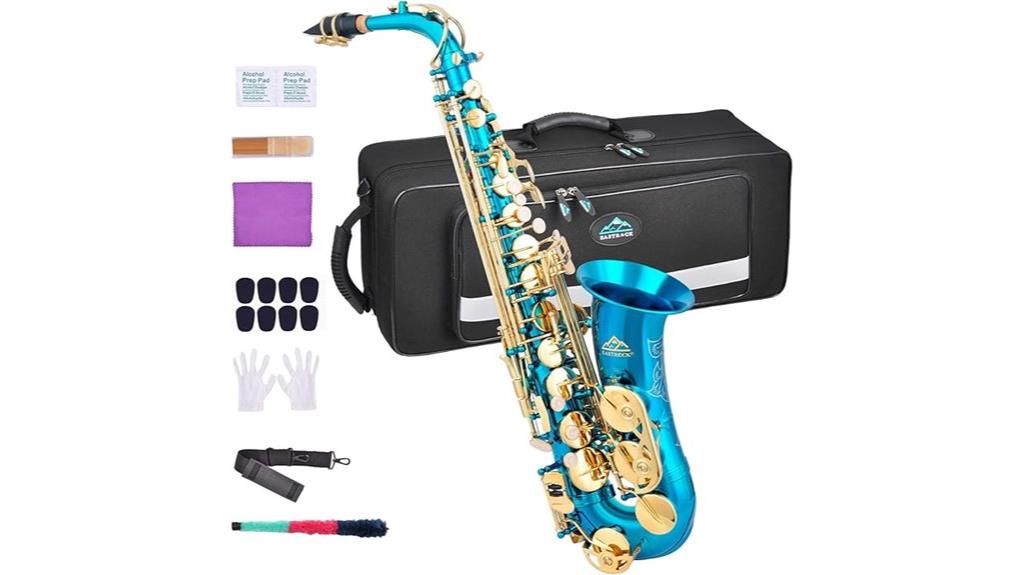
Musicians seeking their first saxophone encounter a delightful surprise with the EASTROCK Light Blue/Golden Alto Saxophone E Flat Sax Full Kit, which transforms the typically overwhelming process of instrument selection into a straightforward decision. You’ll receive everything needed to start playing, including reeds, cleaning supplies, and a carrying case, eliminating the frustration of hunting down accessories separately. The H68 copper construction with multi-layer lacquer finish delivers surprisingly rich sound quality that works across jazz, classical, and contemporary styles, while upgraded leather pads and copper springs guarantee smooth key action that won’t fight your developing technique.
Best For: Students and beginners who want a complete saxophone kit with quality construction, rich sound across multiple music genres, and smooth key action to support developing technique.
Pros:
- Complete kit includes all necessary accessories (reeds, cleaning supplies, carrying case, mouthpiece) eliminating the need to purchase items separately
- H68 copper construction with upgraded leather pads and copper springs delivers rich sound quality and smooth playability across jazz, classical, and contemporary styles
- Strong customer satisfaction with 4.5 out of 5 stars from 636 ratings and ranked #7 in saxophones on bestseller lists
Cons:
- Some customers report that included reeds could be higher quality
- Neck strap comfort could be improved for extended playing sessions
- Cork grease not included in the kit despite being a commonly needed maintenance item
Factors to Consider When Choosing a Sax for Beginner
Now that I’ve shown you how to start playing in just two weeks, I need to help you choose the right saxophone that’ll support your musical journey without breaking your bank account or your back. When I’m working with new students, I always focus on five critical factors: your available budget and ongoing cost considerations, the sound quality standards you can realistically expect, the build material durability that’ll withstand beginner handling, the size and portability requirements for your practice routine, and the included accessories package that determines what additional gear you’ll need to purchase. These considerations work together to guarantee you’ll select an instrument that matches your current skill level, financial situation, and long-term musical goals.
Budget and Cost Considerations
Most beginner saxophonists face a challenging balancing act between their available budget and the quality of instrument they can realistically afford, with entry-level saxophones spanning a surprisingly wide price range from under $200 for basic student models to well over $1,000 for premium beginner instruments. I’ve found that budget-friendly options often include basic accessories, though investing slightly more opens doors to superior mouthpieces and reeds that dramatically enhance playability and sound quality. Don’t forget to factor in additional expenses like maintenance supplies, protective cases, and potential lessons, which collectively increase your total investment. While cheaper saxophones provide adequate practice capability, I’ve noticed that modest budget increases yield significant improvements in sound quality and playing ease, making your learning journey considerably more enjoyable.
Sound Quality Standards
When I evaluate saxophones for beginners, I’ve learned that sound quality standards serve as the foundation for determining whether an instrument will inspire or frustrate a new player’s musical journey. I focus on three critical components: mouthpiece construction, reed compatibility, and overall instrument integrity. Low-quality mouthpieces create airflow restrictions that make tone production unnecessarily difficult, while adjustable features like key height screws and premium pads guarantee proper air tightness. I always recommend instruments that undergo professional sound testing, as they consistently deliver clearer tonal output. Additionally, I suggest upgrading to higher-end reeds immediately, since factory-included reeds often lack the responsiveness needed for vibrant tone development, allowing beginners to experience their instrument’s true potential.
Build Material Durability
Although sound quality forms the foundation of any worthwhile instrument, I’ve discovered that build material durability determines whether a beginner’s saxophone will survive the inevitable learning curve of dropped cases, hasty assembly attempts, and enthusiastic practice sessions. Brass construction offers exceptional strength and resistance to wear, making it my top recommendation for students who’ll inevitably test their instrument’s limits. I’ve found that high-quality leather pads with metal resonators maintain airtightness longer than cheaper alternatives, reducing costly repairs. Multi-layer lacquer finishes protect against scratches and environmental damage while upgraded springs and shell buttons create smoother operation, minimizing maintenance headaches that discourage practice.
Size and Portability
Three fundamental size considerations consistently determine whether beginning saxophone students develop proper technique or struggle with an instrument that fights them at every turn, and I’ve witnessed countless promising musicians abandon their musical journey simply because they chose a saxophone that didn’t match their physical capabilities.
I recommend alto saxophones for most beginners, measuring 25-26 inches in length with manageable weight between 9-12.3 pounds. Soprano models offer lighter alternatives, though their compact design can create intonation challenges I’d rather avoid with new players. The baritone’s substantial bulk overwhelms younger students, making proper posture nearly impossible.
Quality hard-shell cases enhance portability considerably, protecting your investment while enabling comfortable transport to lessons. I’ve learned that comfortable handling directly correlates with practice consistency, making size selection essential for long-term success.
Included Accessories Package
Most saxophone starter packages arrive with four essential accessories that determine whether you’ll spend your first month learning music or scrambling to purchase missing components, and I’ve seen too many students lose momentum simply because their kit lacked basic necessities. Quality packages include reeds, a mouthpiece, neck strap, and cleaning supplies that match your investment level, though I’ll admit I’ve purchased saxophones with accessories so poor they hindered progress more than helped it. Look for kits containing cleaning rods, mouthpiece cushions, and protective cases, as these items cost $150-200 separately and maintain your instrument’s playability. Some manufacturers include instructional materials, which provide technique guidance and maintenance schedules that keep beginners on track during those vital first months.
Brand Reputation History
Beyond the included accessories, you’ll find that brand reputation carries substantial weight in determining whether your saxophone investment delivers reliable performance or becomes a source of constant frustration, and I’ve learned to research manufacturer histories before recommending instruments to my students. Established companies like Yamaha, Selmer, and Jupiter have decades of consistent product development, customer feedback integration, and quality control refinement that translates into dependable beginner instruments. I regularly check customer reviews and ratings, as they reveal real-world durability issues and sound quality concerns that specifications alone can’t capture. Brands with strong educational support networks often provide instructional materials, maintenance guides, and responsive customer service that proves invaluable when you’re starting out and inevitably encounter technical questions or minor adjustments.
Learning Resources Availability
When you’re selecting your first saxophone, I’ve discovered that the availability of quality learning resources can dramatically accelerate your progress, transforming what might otherwise be months of fumbling through basic techniques into a structured, enjoyable learning experience. I recommend prioritizing instruments that come bundled with thorough learning materials, particularly those including detailed fingering charts and progressive exercise sequences found in proven methods like “Essential Elements for Band” or “Rubank Elementary Method.” What’s particularly valuable are packages that incorporate downloadable audio and video components, which provide interactive reinforcement that static printed materials simply can’t match. While structured guides like “How to Play Alto Sax in 14 Days” offer manageable pacing, I’ve found that supplementary resources covering finger placement and basic music theory prove essential for building solid foundational skills.
On a final note
I’ve guided you through the essential saxophones and learning materials that’ll launch your musical journey effectively. Whether you choose the Glory Gold Laquer or EASTROCK models, you’re investing in quality instruments that won’t frustrate your progress. Remember, I’ve learned that the right combination of a decent sax, proper method books, and consistent practice matters more than expensive gear. Your dedication will determine success far more than any instrument’s price tag ever could.

